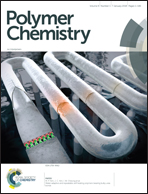Fully recoverable rigid shape memory foam based on copper-catalyzed azide–alkyne cycloaddition (CuAAC) using a salt leaching technique†
Abstract
This study is the first to employ the use of the copper-catalyzed azide–alkyne cycloaddition (CuAAC) polymerization to form a tough and stiff, porous material from a well-defined network possessing a high glass transition temperature. The effect of the network linkages formed as a product of the CuAAC reaction, i.e., the triazoles, on the mechanical behavior at high strain was evaluated by comparing the CuAAC foam to an epoxy-amine-based foam, which consisted of monomers with similar backbone structures and mechanical properties (i.e., Tg of 115 °C and a rubbery modulus of 1.0 MPa for the CuAAC foam, Tg of 125 °C and a rubbery modulus of 1.2 MPa for the epoxy-amine foam). When each foam was compressed uniformly to 80% strain at ambient temperature, the epoxy-amine foam was severely damaged after only reaching 70% strain in the first compression cycle with a toughness of 300 MJ m−3. In contrast, the CuAAC foam exhibited pronounced ductile behavior in the glassy state with three times higher toughness of 850 MJ m−3 after the first cycle of compression to 80% strain. Additionally, when the CuAAC foam was heated above Tg after each of five compression cycles to 80% strain at ambient temperature, the foam completely recovered its original shape while exhibiting a gradual decrease in mechanical performance over the multiple compression cycles. The foam demonstrated almost complete shape fixity and recovery ratios even through five successive cycles, indicative of “reversible plasticity”, making it highly desirable as a glassy shape memory foams.



 Please wait while we load your content...
Please wait while we load your content...